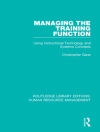Everybody analyses films. Ordinary viewers, chatting on the way home afterwards. Reviewers, telling us just enough to tempt or put off. Critics, ‘situating’ films for us. Moralists, hunting for the (harmful) message. So what exactly is it that film academics do that’s different?
Martin Barker and Thomas Austin provide a jargon-free, accessible and student-friendly introduction to film analysis. They begin with a discussion about audience and a detailed case-study on four conflicting analyses of Capra’s It’s A Wonderful Life. The authors examine a range of popular Hollywood films in a variety of genres, including Titanic, Deep Impact, Sleepless in Seattle, The Lion King, Starship Troopers and The Usual Suspects, and provide vivid demonstrations of what can and can’t be achieved with close textual analysis. The book ends by proposing a list of measures for assessing the adequacy of film analyses: measures intended to lay the basis of a way of doing film analysis which goes beyond theoretically predetermined and often obscurantist assertions.
Explicitly rejecting much of the theoretical baggage that dogs contemporary film analysis, Barker and Austin strip the subject down to its bare essentials. The result is a provocative and timely re-examination of many of the basic tenets in film theory and analysis.
Tabla de materias
Acknowledgements
1. Films, Audiences and Analyses
2. Formalism and the Implied Audience
3. Usual Suspects, Unusual Devices
4. An Ant With Ideas
5. Titanic: A Knight To Remember
6. In the Jungle, the Mighty Jungle
7. Like Food Processors, But Nasty
8. Dear Meg, Dearest Tom
9. A Very Deep Impact (with Thomas Austin)
10. Showing That It Is What It Is
Bibliography
Sobre el autor
Thomas Austin lectures in Media and Film Studies at University of Sussex. He is the author of Watching the World (MUP, 2007), Hollywood: Hype and Audiences (MUP, 2002) and From Antz to Titanic (Pluto Press, 2000).












